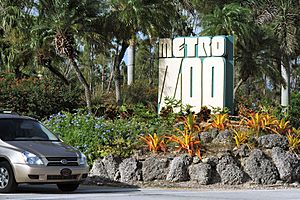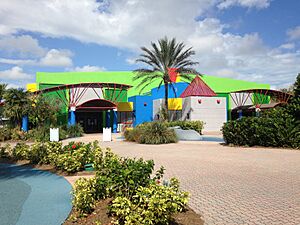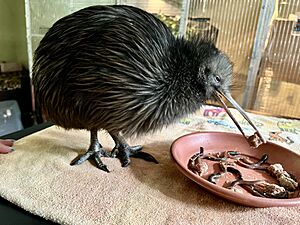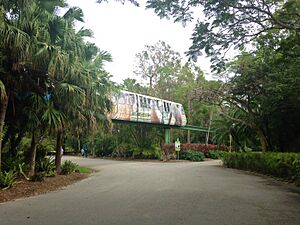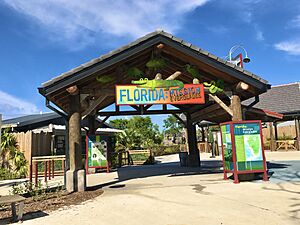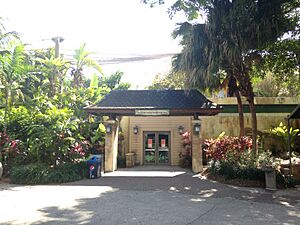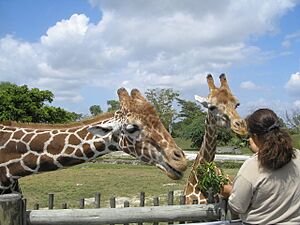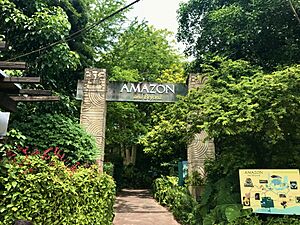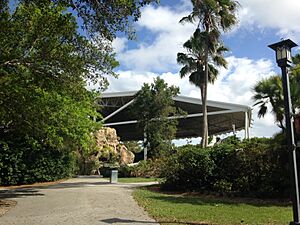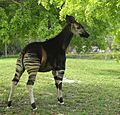Zoo Miami facts for kids
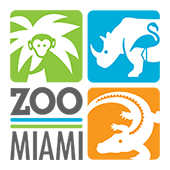 |
|

Entrance from State Road 992.
|
|
| Date opened | 1948 (Crandon Park Zoo) July 4, 1980 (Miami MetroZoo) |
|---|---|
| Location | Miami-Dade County, Florida, United States |
| Land area | 750 acres (304 ha) (324 acres (131 ha) developed) |
| Coordinates | 25°37′N 80°24′W / 25.61°N 80.40°W |
| No. of animals | 3,000 |
| No. of species | 500 |
| Annual visitors | 1+ million |
| Memberships | Association of Zoos and Aquariums |
| Major exhibits | 100 |
Zoo Miami is a super cool place to visit in Miami, Florida! It's also known as the Miami-Dade Zoological Park and Gardens. This zoo is the biggest in all of Florida. It started way back in 1948 as the Crandon Park Zoo. Later, in 1980, it moved to its current spot and was called Miami MetroZoo.
Zoo Miami is special because it's the only tropical zoo in the main part of the United States. It's home to over 3,000 animals from about 500 different kinds of species. The zoo covers a huge area, with 324 acres developed for visitors. You can walk about 4 miles around the paths and see more than 100 different animal exhibits. Zoo Miami is approved by the Association of Zoos and Aquariums (AZA), which means it meets high standards for animal care.
Contents
The History of Zoo Miami
The story of Zoo Miami began in 1948. A small traveling show got stuck near Miami. They traded three monkeys, a goat, and two black bears to pay for truck repairs. These six animals were the start of the Crandon Park Zoo on Key Biscayne. This first zoo was 48 acres big.
More animals joined the zoo, like lions, an elephant, and a rhinoceros from a circus. Some Galapagos tortoises, monkeys, and pheasants also came from a nearby plantation. By 1967, the Crandon Park Zoo had grown a lot. It had over 1,200 animals and was one of the top 25 zoos in the country!
In 1965, a big storm called Hurricane Betsy hit the zoo. Sadly, 250 animals died. After the hurricane, people started talking about building a new zoo. In 1970, officials asked for 600 acres of land at the old Naval Air Station Richmond. Building the new zoo began in 1975.
The new zoo opened on July 4, 1980, as Miami MetroZoo. It first had 12 exhibits. The first major section, Asia, opened in December 1981. At that time, 38 exhibits were open to the public, covering 200 acres.
Growing and Expanding the Zoo
The zoo kept growing in the 1980s. In 1982, 25 more acres opened with six new exhibits for African hoofed animals. The zoo's monorail system started in 1984. These monorail trains came from the 1984 Louisiana World Exposition in New Orleans. They were used at the zoo until 2022.
Wings of Asia, a huge 1.6-acre free-flight aviary (a big birdhouse), opened in December 1984. More African animal exhibits opened in 1985 and 1986. The Australian section of the zoo opened in 1989. PAWS, a children's petting zoo, also opened in 1989. The Asian Riverlife Experience opened in August 1990.
Hurricane Andrew and Recovery
In 1992, Hurricane Andrew caused a lot of damage to the zoo. This very strong hurricane knocked down over 5,000 trees. The Wings of Asia aviary was destroyed, and about 100 of the 300 birds living there were lost. Even though most animals were outside during the storm, only five animals died.
MetroZoo looked very different after the hurricane. It reopened on December 18, 1992. The zoo's tiger exhibit was renamed to honor Naomi Browning, a 12-year-old zoo volunteer who passed away in the storm. By July 1993, many animals that had been moved to other zoos came back to Miami. Over 7,000 new trees were planted to help the zoo's tree cover grow back.
In 1996, a brush fire burned 100 acres of undeveloped land at the zoo. Nearly 30 animals from nearby exhibits had to be moved to safety. That same year, the Falcon Batchelor Komodo Dragon Encounter opened. Later, exhibits for Andean condors (1999), meerkats (2000), Cuban crocodiles, and squirrel monkeys (2001) opened. Dr. Wilde's World, an indoor place for special traveling exhibits, also opened in 2001. The Wings of Asia aviary was rebuilt and reopened in 2003, with more than 300 birds from 70 species.
On July 4, 2010, the zoo changed its name to Zoo Miami as part of its 30th anniversary. This was for marketing and branding. The zoo started a big project to build an Everglades exhibit and a new entrance. The Everglades exhibit opened on December 10, 2016.
In 2017, Hurricane Irma hit South Florida. The Amazon and Beyond exhibit was damaged, and many trees were lost. Sadly, a few birds, including an American flamingo and a Great hornbill, died due to stress. The zoo was closed until October.
In May 2023, there was some concern about a kiwi bird named Paora at Zoo Miami. Some people were worried about how the bird was being handled by visitors and exposed to daylight. The zoo apologized and said it would stop these practices.
Conservation Efforts
Zoo Miami works hard to protect animals and their homes. They support conservation programs locally, nationally, and globally. The zoo was a founding member of the AZA's Butterfly Conservation Initiative. This program helps bring together different groups to save butterflies that are at risk in North America.
The zoo also helps financially through the Zoo Miami Conservation Fund. This fund has helped improve places where animals are bred in zoos in Thailand. This is especially important for endangered animals like clouded leopards and fishing cats.
Exhibits and Animals at Zoo Miami
Zoo Miami has five main exhibit areas: Florida: Mission Everglades, Asia, Africa, Amazon and Beyond, and Australia. When you enter the zoo, you'll see the ticket booths, gift shop, and an exhibit for American flamingos. In the middle of the zoo's paths is the Conservation Action Center. This indoor area has fun, interactive exhibits about protecting wildlife. The zoo also has a large lake called Lake Iguana. Zoo Miami is known for its big, open exhibits that use moats instead of cages.
From 1984 until 2022, a cool monorail system took visitors around the zoo. It gave great views and made it easy to get between sections. The monorail had four stations. Narrated tram rides and guided tours were also available daily. The monorail was stopped because it cost too much to keep it running.
Florida: Mission Everglades
The Florida: Mission Everglades exhibit shows off animals and plants that live in Florida, especially in the Everglades region. You can see American alligators, American crocodiles, North American river otters, bobcats, American black bears, Florida panthers, raccoons, gray foxes, bald eagles, American white pelicans, and roseate spoonbills. This exhibit also has a fun, gentle airboat ride called Lostman's River Ride.
Asia
The Asia exhibit at Zoo Miami has many animals from Asia. You can see Bornean orangutans, Asian elephants, Indian rhinoceros, Sumatran tigers, and Komodo dragons. There are also many kinds of Asian birds. The American Banker's Family Aviary, Wings of Asia, is a walk-through birdhouse. It's home to about 85 different kinds of birds.
Some Birds You Might See:
- Javan pond heron
- Painted stork
- White stork
- Magpie goose
- Mandarin duck
- Bar-headed goose
- Red-breasted goose
- Spotted whistling duck
- Falcated duck
- Indian spot-billed duck
- Australian shoveler
- Marbled teal
- Ruddy shelduck
- Tufted duck
- Scaly-sided merganser
- White-winged duck
- Green peafowl
- Great argus
- Germain's peacock-pheasant
- Edward's pheasant
- Green junglefowl
- Masked lapwing
- Grey-headed swamphen
- Black bulbul
- Buff-banded rail
- Pied imperial pigeon
- Nicobar pigeon
- Red-knobbed imperial pigeon
- Green-naped pheasant pigeon
- Victoria crowned pigeon
- Mindanao bleeding-heart
- Luzon bleeding-heart
- Red-vented bulbul
- White-eared bulbul
- Fawn-breasted bowerbird
- Black-throated laughingthrush
- Black-naped oriole
- Metallic starling
- Black-collared starling
- White-eared catbird
- Azure-winged magpie
- Great hornbill
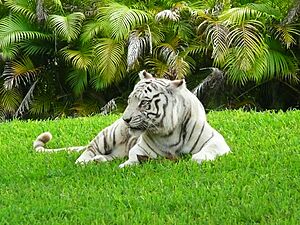
The zoo's orangutan exhibit once had Nonja, a female Sumatran orangutan. She was thought to be the oldest of her kind before she passed away in 2007. Another famous animal was Carlita, a 21-year-old female white Bengal tiger. She lived at the zoo from 1994 until she passed away in 2013.
The Asia exhibit is also home to two Asian elephants: an older female named Nellie and a young male named Ongard. The American Banker's Family Aviary, Wings of Asia, is also here. It has 300 rare birds from 70 species. It's the largest open-air Asian aviary in the Western Hemisphere. The Children's Zoo lets guests get close to animals. You can see meerkats, a petting zoo, and small reptiles, amphibians, and insects. There are also butterfly gardens, an animal-themed carousel, and a dromedary camel area.
Africa
The Africa section of the zoo has animals from different parts of Africa. You can see reticulated giraffes, pygmy hippos, African bush elephants, eastern black rhinoceroses, greater kudus, chimpanzees, western lowland gorillas, and okapis. Zoo Miami has one of the most varied collections of hoofed animals in the United States.
Amazon and Beyond
Amazon and Beyond opened in December 2008. It's a collection of animals from South America. This area has 27 acres dedicated to the plants and animals of South America. It's divided into four parts: Village Plaza, Cloud Forest, Amazon Flooded Forest, and Atlantic Forest. These areas show habitats found in the Amazonian region. You can see animals like giant otters, jaguars, Orinoco crocodiles, giant anteaters, black howler monkeys, Hoffmann's two-toed sloths, harpy eagles, bats, and poison dart frogs.
Australia
The Australia habitat at the zoo shows animals from Australia, Oceania, and the Pacific islands. You can see koalas, southern cassowaries, southern hairy-nosed wombats, and Matschie's tree-kangaroos. Near this habitat is the Sami Family Amphitheater, which seats 800 people. Daily animal shows, concerts, and cultural events are held here.
The amphitheater is named after Albert and Winifred Sami, who gave a lot of money to the zoo. In late 2024, it started having rotating exhibits for animal ambassadors like cheetahs, servals, and giant anteaters. Zoo Miami celebrated the birth of a baby koala named Hope. Hope was born in May 2019 and first came out of her mother's pouch on January 8, 2020. She was named Hope because of the fires that happened in Australia.
Near the Australian habitat, there's a trail with Galapagos giant tortoises, babirusas, red river hogs, common warthogs, and Visayan warty pigs.
Images for kids
-
African elephant at the zoo
-
American flamingos (Phoenicopterus ruber)
-
Orangutan at the zoo
-
Sumatran tiger (Panthera tigris sondaica)
-
Lar gibbon (Hylobates lar)
-
Black-naped oriole (Oriolus chinensis)
See also
 In Spanish: Zoológico de Miami para niños
In Spanish: Zoológico de Miami para niños
- Gold Coast Railroad Museum (right next to Zoo Miami)
- Nonja (Malaysian orangutan)
- Rosie the Elephant


